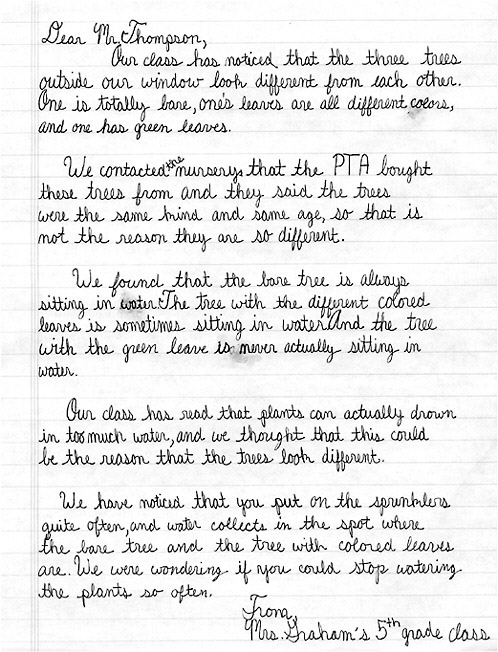1
Inquiry in Science and in Classrooms
Scientific inquiry refers to the diverse ways in which scientists study the natural world and propose explanations based on the evidence derived from their work. Inquiry also refers to the activities of students in which they develop knowledge and understanding of scientific ideas, as well as an understanding of how scientists study the natural world. National Science Education Standards, p. 23.
As pointed out in the National Science Education Standards (National Research Council, 1996), students who use inquiry to learn science engage in many of the same activities and thinking processes as scientists who are seeking to expand human knowledge of the natural world. Yet the activities and thinking processes used by scientists are not always familiar to the educator seeking to introduce inquiry into the classroom. By describing inquiry in both science and in classrooms, this volume explores the many facets of inquiry in science education. Through examples and discussion, it shows how students and teachers can use inquiry to learn how to do science, learn about the nature of science, and learn science content.
A good way to begin this investigation is to compare the methods and thinking process of a practicing scientist with the activities of an inquiry-based science lesson. The stories in this chapter set the stage for many of the themes to follow. The sidebars suggest some important aspects of the investigations of both scientists and students.
INQUIRY IN SCIENCE
A geologist who was mapping coastal deposits in the state of Washington was surprised to discover a forest of dead cedar trees near the shore. A significant portion were still standing, but they clearly had been dead for many years. He found similar
Makes observations
stands of dead trees at other places along the coast in both Oregon and Washington. He wondered, “What
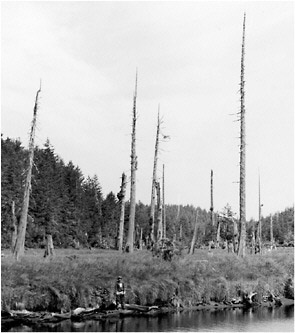
could have killed so many trees over so wide an area?”
Reflecting on his knowledge of earthquakes, crustal plate boundaries, and subsidence along coastlines, the geologist searched for possible explanations. “Did the trees die at the same time?” “Was their death related to nearby volcanic activity or some kind of biological blight?” “Given their coastal location, was there some relationship between the salt water and the destruction of the forests?”
Exhibits curiosity, defines questions, from knowledge background
He pursued his first question by dating the outer rings of the trees using carbon 14 radiometric methods. He found that they all had died about 300 years ago. As for the cause of the trees’ death, his mapping indicated no evidence for widespread volcanic deposits in the areas of dead forests. Furthermore, the trees were not burned, nor did careful examination indicate any evidence of insect infestation.
Gathers evidence using technology and mathematics
The geologist began thinking about the possible role of salt water in killing the trees. He recalled that a large section of the Alaskan coast dropped below sea level in 1964 when the tectonic plate that underlies much of the Pacific Ocean plunged beneath the North American tectonic plate that Alaska sits on as the result of a major “subduction zone earthquake.” Many square miles of coastal forests in Alaska died when the coastline dropped and they were submerged in salt water following the earthquake. He knew that a similar subduction zone lies beneath the Washington and Oregon coast and gives rise to the volcanoes of the Cascade mountains. He wondered whether the trees in Washington and Oregon might have been drowned by sea water when a large section of the coast subsided during an earthquake 300 years ago.
Uses previous research
To check this explanation, he collected more data. He examined the sediments in the area. Well-preserved sections of sediment exposed in the banks of streams inland from the stands of dead trees showed a clean
Propose a possible explanation
layer of sand below the soil — unlike any of the dark, clay-rich soil above and below the sand. “Where did the white sand come from?” he wondered.
The geologist knew that subduction zone earthquakes often produce tsunamis — tidal waves. He thought the sand layer could be sand washed ashore during a tsunami. If so, this would be further evidence of a major coastal earthquake. Fossils recovered from the sand layer indicated the sand came from the ocean rather than being washed down from inland, supporting the tsunami hypothesis.
He published several articles in peer-reviewed scientific journals hypothesizing that the dead trees and sand layer found along the coast were evidence that a major earthquake occurred about 300 years ago, just before European settlers arrived in the region (Atwater, 1987; Nelson et al., 1995).
Publishes explanation based on evidence
Several years later a Japanese seismologist, who was studying historic tide gauge records in Japan to document tsunamis from distant sources, identified a major earthquake somewhere along the Pacific rim on January 17, 1700, but the source of the earthquake was open to debate. Using historical records he was able to eliminate the possibility of a large earthquake from most known earthquake source regions around the Pacific. Aware of the geologist’s work on dead forests in the Pacific northwest, the Japanese seismologist suggested that the source of the tsunami was a large subduction zone earthquake beneath present day Oregon and Washington (Satake et al., 1996).
Considers new evidence
Now the geologist had more evidence supporting his explanation that the sand layer was caused by a tsunami that accompanied an earthquake. Further examination of coastal sediments uncovered additional, but older, remains of dead trees and sand layers. He now thinks that earthquakes producing very large tsunamis, like the one he first identified, have repeatedly struck the Pacific Northwest coast in the past thousand years, just as these large earthquakes strike other subduction zones beneath Japan, the Philippines, Alaska, and much of Western South America. The coastal subsidence caused by the earthquake submerged the trees in salt water, which led to their death.
Adds to explanation
As sometimes occurs with scientific research, the geologist’s findings influenced public policy. Public officials have revised the building codes for Washington and Oregon, based on the deeper understanding of earthquakes that grew out of this research. New buildings must be designed to resist earthquake forces 50 percent larger than under the old code.
Explanation informs public policy
This story illustrates several important features of scientific inquiry. A scientist noticed a phenomenon and had the curiosity to ask
questions about it. No doubt many other people had also noticed the dead trees, but they either did not wonder about the cause of death or were not in a position to answer the question. Using his knowledge of geology and what he learned about trees and their habitats, the geologist made connections between the dead trees and other features of the environment, such as the coastal location. Those questions guided his investigation, which included the use of carbon 14 methods to date the dead trees and the gathering of available knowledge about the geology of the region. He developed an explanation for the death of the trees based on this preliminary evidence and gathered more evidence to test his explanation. He then published articles in which he discussed the relationship between the evidence he accumulated and the explanation he proposed. Later, a scientist in another part of the world read the publications and, because
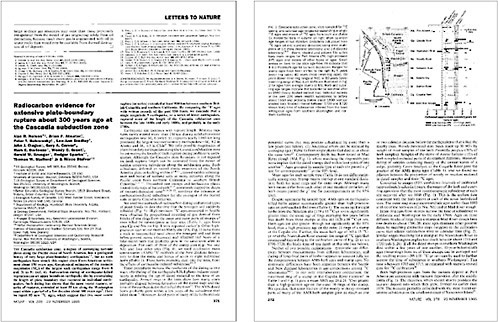
Geologist’s report of his findings published in the journal Nature
scientists use universal descriptions and measurements, was able to compare his findings with those of the American scientist. The Japanese scientist obtained separate evidence — the occurrence of a tsunami on January 17, 1700 — that gave further support to the hypothesis that a subduction zone earthquake occurring on that date led to the death of a large number of trees along the Pacific Northwest coast.
THE NATURE OF HUMAN INQUIRY
The geologist’s search for understanding of the natural world is a good illustration of the human characteristics that make inquiry such a powerful way of learning. Humans are innately curious, as anyone knows who has watched a newborn. From birth, children employ trial-and-error techniques to learn about the world around them. As children and as adults, when faced with an unknown situation, we try to determine what is happening and predict what will happen next. We reflect on the world around us by observing, gathering, assembling, and synthesizing information. We develop and use tools to measure and observe as well as to analyze information and create models. We check and re-check what we think will happen and compare results to what we already know. We change our ideas based on what we learn.
This complex set of thinking abilities, which helped early humans gather food and escape danger, constitutes the highly developed capacity we refer to as inquiry. In recent human history, some people have directed their curiosity toward issues other than subsistence and survival — for example, the movement of celestial objects, the causes of seasons, the behavior of moving objects, and the origins of organisms. Curiosity about such issues is unique to humans. People studied these phenomena, developing hypotheses and proposing explanations. The communication of hypotheses, ideas, and concepts among individuals shaped the strategies, rules, standards, and knowledge that we recognize today as scientific.
Inquiry into the natural world takes a wide variety of forms. It can range from a child’s wondering how it is possible for ants to live underground to the search by groups of physicists for new atomic particles. Inquiry in classrooms also takes a wide variety of forms, as described later in this volume. But whatever its exact form, its role in education is becoming an increasing focus of attention. Today the world is being profoundly influenced by scientific discoveries. People need to make and evaluate decisions that require careful questioning, seeking of evidence, and critical reasoning. Learning environments that concentrate on conveying
to students what scientists already know do not promote inquiry. Rather, an emphasis on inquiry asks that we think about what we know, why we know, and how we have come to know.
Inquiry is at the heart of the National Science Education Standards. The Standards seek to promote curriculum, instruction, and assessment models that enable teachers to build on children’s natural, human inquisitiveness. In this way, teachers can help all their students understand science as a human endeavor, acquire the scientific knowledge and thinking skills important in everyday life and, if their students so choose, in pursuing a scientific career.
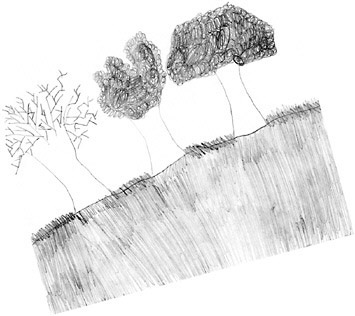
INQUIRY IN THE SCIENCE CLASSROOM
One of the best ways to understand school science as inquiry is through a visit to a classroom where scientific inquiry is practiced. The following vignette features a particular grade, but, as illustrated throughout this book, classroom inquiry can and does happen at all grade levels. Sidebars point out some ways inquiry is occurring.
Several of the children in Mrs. Graham’s fifth grade class were excited when they returned to their room after recess one fall day. They pulled their teacher over to a window, pointed outside, and said, “We noticed something about the trees on the playground. What’s wrong with them?” Mrs. Graham didn’t know what they were concerned about, so she said, “Show me what you mean.”
The students pointed to three trees growing side by side. One had lost all its leaves, the middle one had multicolored leaves — mostly yellow — and the third had lush, green leaves. The children said, “Why are those three trees different? They used to look the same, didn’t they?” Mrs. Graham didn’t know the answer.
Mrs. Graham knew
that her class was scheduled to study plants later in the year, and this was an opportunity for them to investigate questions about plant growth that they had originated and thus were especially motivated to answer. Although she was uncertain about where her students’ questions would lead, Mrs. Graham chose to take the risk of letting her students pursue investigations under her guidance. After all, they had had some experience last year in examining how seeds grow under different conditions. She hung up a large sheet of butcher paper where all the students could see it and said, “Let’s make a list of ideas that might explain what’s happening to those three trees outside.” A forest of hands went up:
Exhibit curiosity, define questions from current knowledge
It has something to do with the sunlight.
It must be too much water.
It must not be enough water.
The trees look different. They used to look the same.
It’s the season, some trees lose their leaves earlier than others.
There is poison in the ground.
The trees have different ages.
Insects are eating the trees.
One tree is older than the others.
Propose preliminary explanations or hypotheses
When the students were satisfied that they had enough ideas, Mrs. Graham encouraged them to think about which of their ideas were possible explanations that could be investigated and which were descriptions. She then invited each student to pick one explanation that he or she thought might be an answer. She grouped the students by choices: There was a “water group”, a “seasons” group, an “insects” group, and so on. She asked each group to plan and conduct a simple investigation to see if they could find any evidence that answered their question. As they planned their investigations, Mrs. Graham visited each group of students
Plan and conduct simple investigation
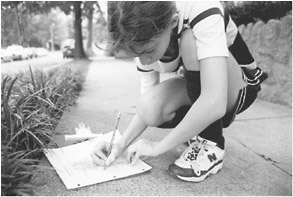
and carefully listened as they formulated their plans. She then asked each group to explain their ideas to their classmates, resulting in further refinement. Using this quick and public assessment of where they were, she was able to help them think about the processes they were using to address their question and consider whether other approaches might work better.
Gather evidence from observation
For the next three weeks, science periods were set aside for each group
to carry out its investigation. The groups used a variety of sources to gather information about characteristics of trees, their life cycles, and their environments. For example, the “different ages” group answered their question fairly quickly. They contacted the PTA members who were involved in planting that part of the playground and found the original receipts for the purchase of the trees. A check with the nursery indicated that all three trees were identical and of approximately the same age when purchased. As some groups completed their investigations early, Mrs. Graham invited their members to join other groups still in progress.
Explain based on evidence
The water group decided to look at the ground around the trees every hour that they could. They took turns and jointly kept a journal of their individual observations. Since some students lived near the school, their observations continued after school hours and on weekends. They missed some hourly observations, but they had sufficient data to report to the class. “The tree without leaves is almost always standing in water, the middle tree is sometimes standing in water, and the green tree has damp ground but is never standing in water.”
One of the students recalled that several months ago the leaves on one of his mother’s geraniums had begun to turn yellow. She told him that the geranium was getting too much water. Mrs. Graham gave the group a pamphlet from a local nursery entitled “Growing Healthy Plants.” The water group read the pamphlet and found that when plant roots are surrounded by water, they cannot take in air from the space around the roots and they essentially “drown.” Based on their observations and the information they obtained from the pamphlet, the students concluded that the leafless tree was drowning, the middle tree was “kinda” drowning, and the third one was “just right.”
Consider other explanations
The water group continued its work by investigating the source of the water. They found that the school custodian turned on a lawn sprinkler system three times a week. He left it running longer than necessary, and the excess water ran off the lawn and collected at the base of the trees. Since the ground was sloped, most of the water collected at one end of the tree-growing area. Together with the other groups, they reported their results to the rest of the class.
As different groups gave their reports, the class learned that some observations and information — such as those from the group investigating whether the trees were different — did not explain the observations. The results of other investigations, such as the idea that the trees could have a disease, partly supported the observations. But the explanation that seemed most reasonable to the students, that fit all the observations and conformed with what they had
Communicate explanation
learned from other sources, was too much water. After their three weeks of work, the class was satisfied that together they had found a reasonable answer to their question. At Mrs. Graham’s suggestion, they wrote a letter to the custodian telling him what they had found. The custodian came to class and thanked them. He said he would change his watering procedure and he did. Mrs. Graham then asked the students how they could find out if their explanation was correct. After some discussion they decided that they would have to wait until next year and see if all the trees got healthy again.
The following year, during the same month that they had observed the discrepancy, all three trees were fully clothed with green leaves. Mrs. Graham’s former students were now even more convinced that what they had concluded was a valid explanation for their observations.
Test explanation
PARALLELS BETWEEN INQUIRY IN EDUCATION AND IN SCIENCE
One is struck by the parallels between Mrs. Graham’s class and the inquiring geologist. The geologist began his investigation with a question about an unusual and intriguing observation of nature. So did Mrs. Graham’s children. The scientist then undertook a closer examination of the environment — asked new and more focused questions — and proposed an explanation for what he observed, applying his knowledge of plate tectonics. The children applied their knowledge to formulate several explanations and new questions before undertaking further investigations. The scientist, knowing of investigations by other scientists, used their findings to confirm the validity of his original explanation. In Mrs. Graham’s class, groups whose explanations were not confirmed lent strength to the “excess water” explanation. The geologist published his findings. The children “published” their findings in their reports to their classmates and later in a letter to the custodian. Although scientific research does not always influence public policy, the geologist’s discoveries resulted in building code revisions in Washington and Oregon. The children’s investigations led to revised lawn watering procedures at their school.
Inquiry in the classroom can take many forms. Investigations can be highly structured by the teacher so that students proceed toward known outcomes, such as discovering regularities in the movement of pendulums (as noted in the Foreword and in the classroom vignette on pages 146-147 of the National Science Education Standards). Or investigations can be free-ranging explorations of unexplained phenomena, like the tree leaf discrepancies in Mrs. Graham’s schoolyard. The form that inquiry
takes depends largely on the educational goals for students, and because these goals are diverse, highly structured and more open-ended inquiries both have their place in science classrooms.
The chapters that follow explore the dimensions of teaching and learning science as inquiry across a broad range of ages and scientific topics. The intention is to improve the quality of student learning by enabling them to acquire the abilities of inquiry, develop knowledge of scientific ideas, and understand the work of scientists.

